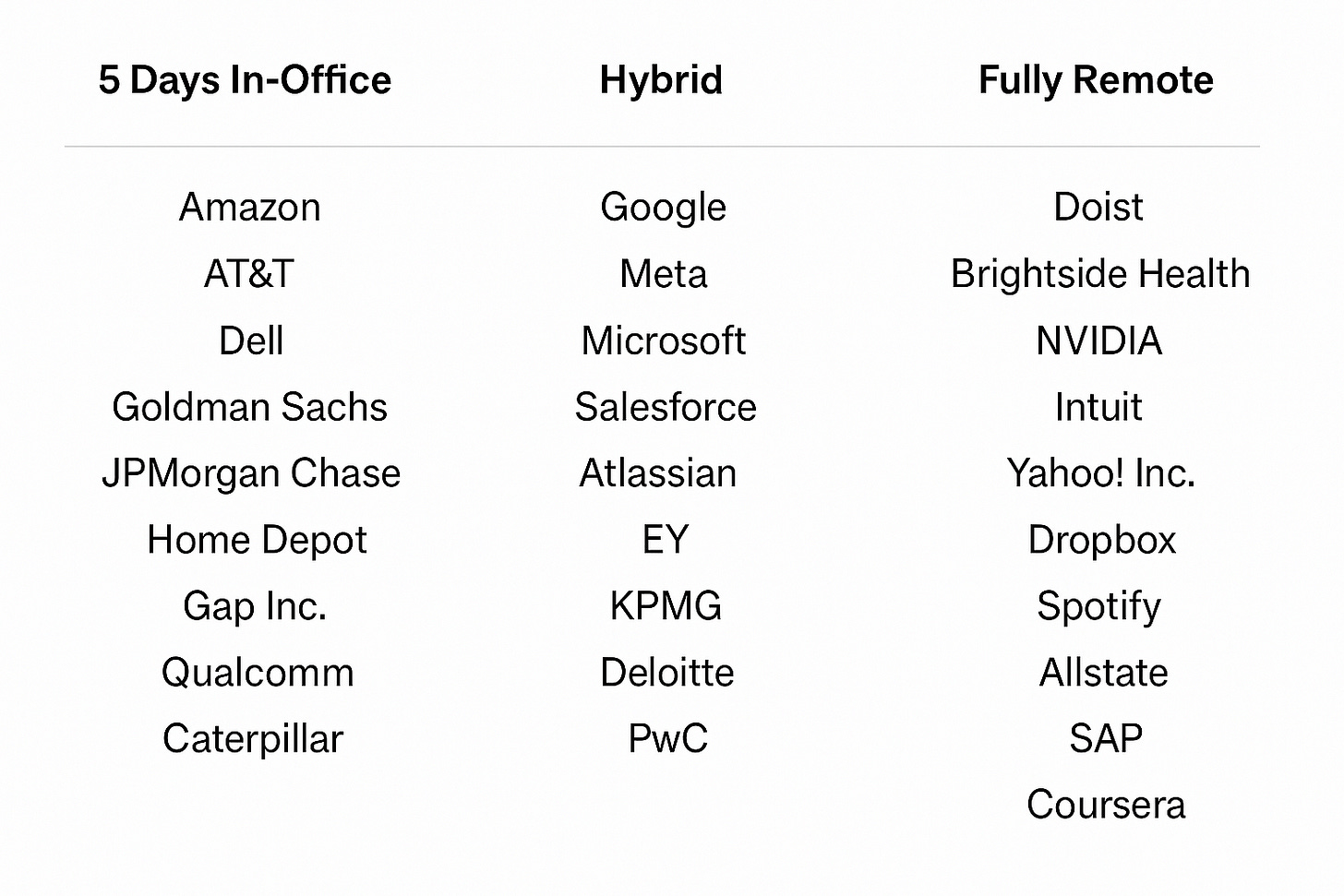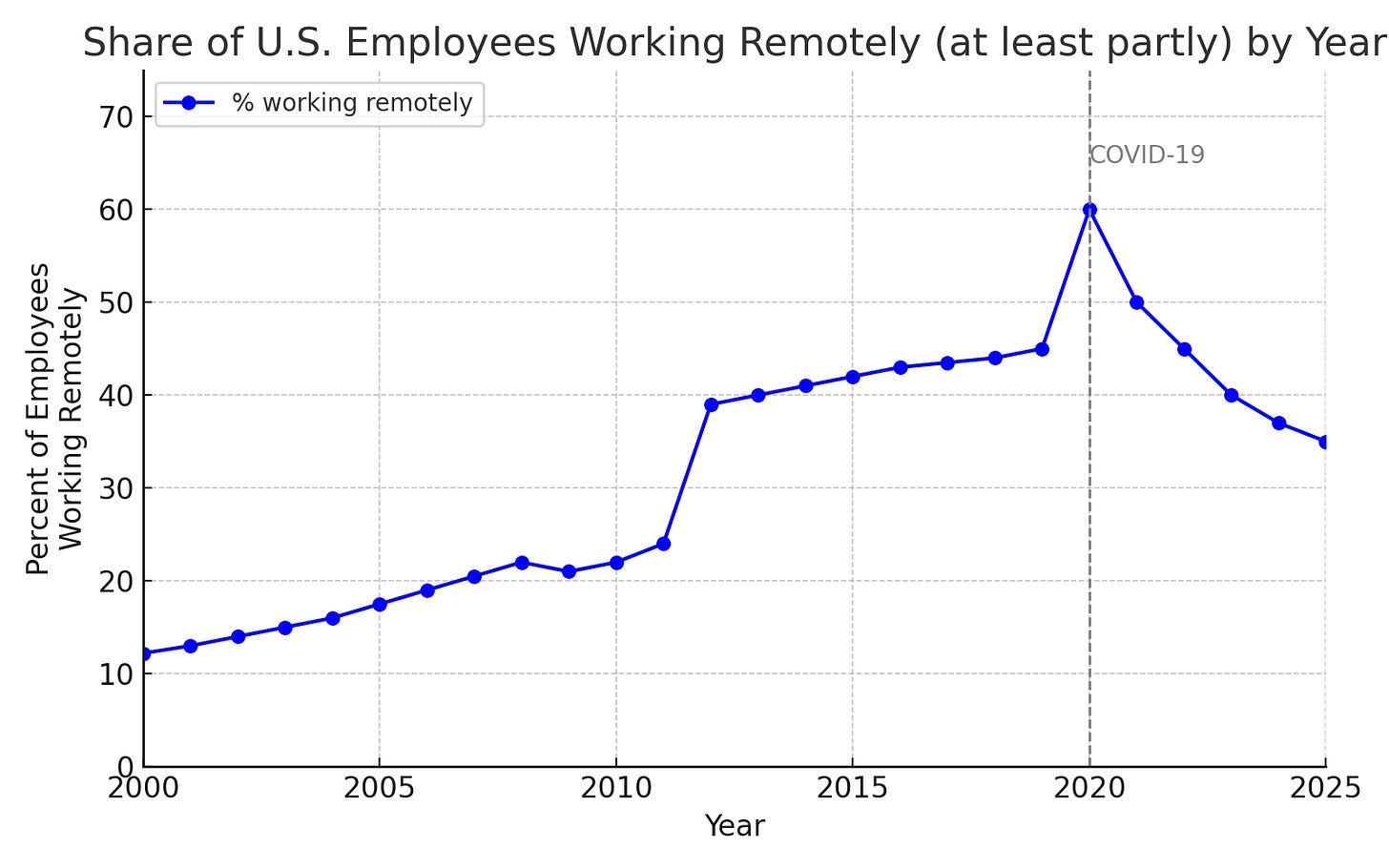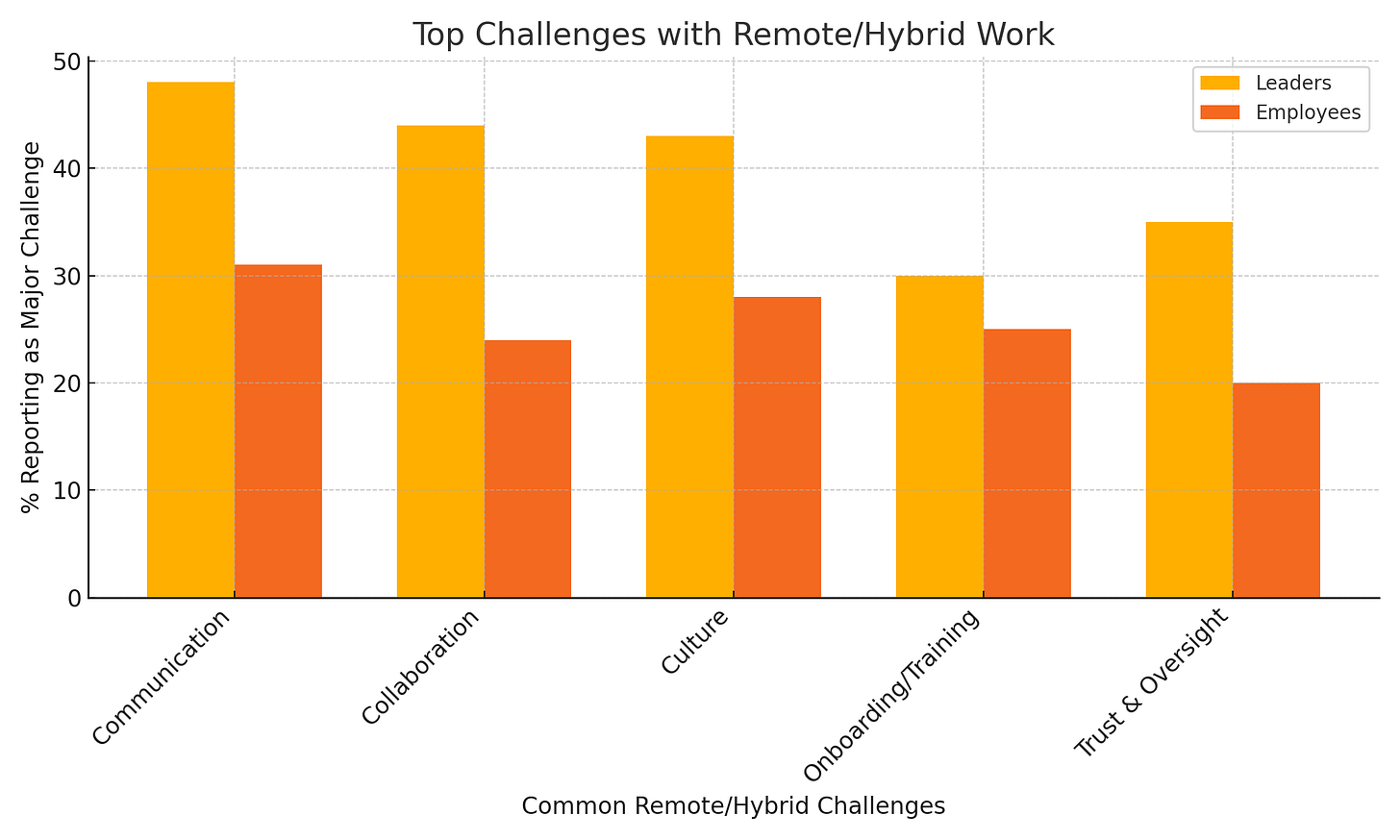Remote Work: Flexibility or Friction?
The remote debate is far from over — and the winners aren’t always the ones yelling loudest
Remote Isn’t New, But It’s Still Misunderstood
I remember a decade ago, long before COVID was even a plot twist, debating whether remote employees could be as effective as office dwellers. The answer was “no”.
Candidly, as a former consultant, when at client sites, I wouldn’t say I observed 100% productivity in onsite associates either. So, how could a remote associate possibly be “as productive”?
Fast forward to today: we’ve all lived the grand work-from-home experiment, yet the argument rages on. Some CEOs insist everyone trek back to HQ, citing culture or productivity fears.
For example, Amazon and AT&T have mandated that corporate employees return to the office five days a week. While the long-term impact remains to be seen, a study from the University of Pittsburgh found that strict RTO policies can lead to a 14% increase in employee turnover, underscoring the potential risks associated with such mandates.
Meanwhile, plenty of workers (and not a few studies) say, “Actually, we’re doing just fine in our pajamas, thank you.” Remote work isn’t a new concept; it has existed in various forms for years.
The conversation has become polarized: Is remote work the ultimate perk driving productivity and happiness, or a silent killer of culture, accountability, and progress?
Having observed both successful and disastrous distributed teams, I believe the reality lies somewhere in between. The debate over flexibility versus friction is not about choosing sides in an ideological conflict. It’s about grasping the complexities involved.
Let’s cut through the noise and look at what’s happening with remote work, the data, the struggles, the success stories, and the strategic trade-offs. By the end, I aim to give you a candid take on why remote work can work (and when it doesn’t, what’s actually to blame), so you can make smarter decisions for your business. Buckle up, because the ride isn’t over yet.
What the Latest Research Shows
(Hint: Hybrid Wins)
If you sift through the latest research from places like Stanford, McKinsey, and Gallup, a clear theme emerges: extreme stances (all remote or all in-office) rarely outperform a thoughtful hybrid approach.
The data is painting a picture that should make the loudest voices on either end a bit uncomfortable.
Take productivity and performance. A new study by Stanford economist Nicholas Bloom, published in Nature, tracked 1,600 employees at a large global travel company to test the impact of remote work.
The result? Employees who worked from home two days a week were just as productive and just as likely to get promoted as those in the office full-time.
In other words, a balanced schedule didn’t hurt output at all. It did slash turnover: when the company let employees go hybrid (2 days at home, 3 in office), employee quit rates plummeted by a whopping 33%.
Fewer people quit, the company saved millions on rehiring, and nobody’s career progression stalled. As Professor Bloom put it,
“The results are clear: Hybrid work is a win-win for productivity, performance, and retention.”
What about fully remote work? Here, the story is a tad more complicated.
Bloom and colleagues have also found that fully remote setups can come with a productivity penalty of roughly 10% on average.
The culprits are what you’d expect: communication hurdles, harder collaboration, and the fact that it’s tough to replicate in-person mentorship over video.
However, and this is important, the average hides a lot of variation. Some companies manage remote work exceptionally well and see productivity climb; others struggle.
Plus, fully remote brings its own benefits that offset some of those challenges: companies save on real estate and can tap global talent pools to hire skill sets they might not find locally.

A 10% hit in one area might be an acceptable trade for a 30% larger talent pool or lower costs. So, context matters. A slight productivity dip doesn’t automatically make remote work a bad choice if you’re gaining elsewhere (more on trade-offs later).
Now, hybrid work, the mix of office and home, offers many of the upsides of both with fewer downsides. In the Stanford experiment above, hybrid workers saw no drop in performance versus their office peers.
And beyond that single study, a working paper by Stanford researchers concluded that hybrid working has essentially no impact on productivity overall, while significantly improving employee recruitment and retention.
It’s no wonder hybrid models have exploded in popularity. Plus, the data says a typical U.S. employer stands to save $11,000 a year for each employee who works remotely 2-3 times a week. This adds up to $1M for every thousand employees.
Let’s talk popularity: what are companies doing in the real world? According to a Gallup survey, hybrid is now the dominant way of work for “remote-capable” jobs.
In 2019 (pre-pandemic), ~60% of employees were fully on-site; by 2023, that number fell to just 20%. Hybrid arrangements shot up to roughly half of all workers; the remaining ~30% are remote. That’s a seismic shift in a few years.
And contrary to the idea that we’re all headed back to the office eventually, most workers expect to stick with their current remote/hybrid setup long-term.
In fact, 8 in 10 Fortune 500 CHROs say they have no plans to dial back remote flexibility in the next year. The experiment, it seems, has proven its value enough that flexibility is here to stay for the majority.
It’s also worth noting that when McKinsey surveyed thousands of employees in 2024 after a wave of return-to-office pushes, they found no clear “productivity winner” among in-person, hybrid, or remote workers.
Employees across all models reported similar performance and engagement overall. That’s a sign that any model can deliver results with the right sorting and some adaptability.
However, companies did double down on return-to-office in 2024 – the share of mostly in-person workers jumped from 34% to 68% in McKinsey’s sample – so we’re seeing a correction where some who went fully remote are coming back to hybrid. But again, those shifts haven’t made a dramatic dent in productivity metrics one way or the other.
One more nuance on the data: it suggests the impact of remote/hybrid work is role-dependent and industry-dependent. Not every job can be done remotely (obvious example: you can’t fix factory machines or serve restaurant guests from home).
Even within knowledge work, the effectiveness of remote work can vary. Roles heavy on individual focus work (software developers, writers, analysts) tend to thrive with fewer interruptions, and remote work can be a boon.
Roles requiring a lot of spontaneous collaboration or hands-on interaction (creative teams, some R&D, client-facing sales) may find remote work more limiting. Surveys indicate that employees in jobs requiring frequent in-person contact report that the hybrid isn’t as beneficial for them.
So, smart companies should look at which roles are remote-friendly and tailor policies accordingly. Blanket one-size-fits-all proclamations (“remote good” or “remote bad”) ignore that nuance. The best approach might be hybrid overall, but with flexibility for certain teams to convene more often if their work benefits from it.
The bottom line from the research is that remote work, especially in hybrid form, is not only viable, but it often matches or beats the old in-office model in terms of key outcomes like productivity, engagement, and retention.
Companies that rigidly oppose any remote work might be fighting the last war. As Bloom noted, about 80% of U.S. companies now offer some remote work options, and those clinging to 2019’s playbook may be “paying a price” in talent loss.
But that doesn’t mean remote work is a magic bullet either. To understand why some firms still struggle, let’s talk about the friction points that make many leaders wary.
Why Remote Gets a Bad Rap
(Leader Frustrations & Misconceptions)
Communication, collaboration, and culture consistently top the list of hybrid work challenges for both employees and leaders, highlighting why some companies struggle with remote models.
Despite the positive data, I’ve had plenty of candid chats with executives who loathe remote work. If you’re a leader who has felt that managing a distributed team is like herding cats in the dark, you’re not alone. Some common struggles keep coming up, and remote work often gets blamed for them (sometimes fairly, often not). Let’s unpack a few:
1. “Our culture is fading.” Many leaders worry that without the office, culture will collapse. No hallway chats, no team lunches, no shared energy. There may be some truth to this; however, culture isn’t built by proximity alone; it’s built by intention.
The best companies are deliberate: they define values clearly, build mentoring habits, and create new ways to connect, from virtual coffees to intentional rituals. Remote work can strain culture, but only breaks it if you let it.
2. Onboarding and developing talent. One common complaint: “How do we train new hires remotely?” It’s harder, no question. Without casual interactions or shadowing, new employees can feel lost. But the real issue often isn’t remote work, it’s unprepared managers who may never have learned how to onboard outside the office.
Remote onboarding works when structured, assigning a mentor, scheduling daily check-ins, and clearly communicating expectations. Companies that fail at this usually do onboarding poorly in person, too. Instead of blaming the remote, smart leaders invest in training, documentation, and support systems to close the gap.
3. Communication and collaboration breakdowns. In the office, quick questions happen naturally. Remotely, that spontaneity disappears, especially across time zones. Misunderstandings are more common, silos form, and collaboration slows without intention.
But these issues are fixable. High-performing remote teams set clear norms, use chat for quick updates, document big decisions, and encourage over-communication.
4. “How do I know they’re working?” Some managers struggle with remote work because they don’t trust what they can’t see. Having managed remote teams for most of my career, I can relate. It is frustrating at times.
However, I have learned that people can also look busy in the office.
The key to all of this (remote or otherwise) is to focus on outcomes, not activity. Set clear expectations and ensure individuals are hitting their goals. There is a delicate balance for sure, as one cannot constantly be asking for updates or checking over shoulders.
Micromanaging only kills morale. The fix is training managers to lead by results and building a culture where adults are treated like adults. Remote work reveals performance; it doesn’t hide it.
How Top Companies Are Making Remote (and Hybrid) Work
So, what are innovative companies, those “winners” who aren’t just shouting on LinkedIn about hustle culture or remote utopia, actually doing to get the best of both worlds?
In my experience and research, high-performing companies treat work models as a strategic challenge and have converged on a few key practices:
Structured Hybrid Schedules (“Anchor Days”). One emerging best practice is to designate certain days where everyone (or almost everyone) is in the office, and leave the rest flexible.
For example, Uber implemented “anchor days” on Tuesdays and Thursdays. On those days, all hybrid employees come in, guaranteeing in-person overlap. The other days, people can work remotely.
This approach satisfies both camps: collaboration and social connection happen on anchor days (since critical mass is there), while individuals get freedom and focus time at home on others.
Many companies do some variant: common in-office days, sometimes centered around team needs, or all-hands meetings. I’ve heard some firms refer to Wednesday as the “collaboration day” company-wide, keeping Mon/Fri remote for focus or personal flexibility.
The key is predictability, so that people know when to schedule critical face-to-face interactions and when they won’t be dragged into the office needlessly. It also prevents the worst-case hybrid scenario of a half-empty office daily (where you only sit on video calls because half your team stayed home, nobody likes that).
Anchor days give hybrid structure. And culturally, there’s something nice about saying, “Tuesday is the day we all see each other, let’s do our team lunch then.” It builds a rhythm.
“Virtual-First” and Async Communication. On the flip side of structured hybrid, some companies have leaned into being remote-first, meaning they operate as if everyone is remote, even if they have offices. I know this sounds a bit “odd”.
A great example is Dropbox, which pivoted to a “Virtual First” model. They ditched the idea of routine mandatory office days. Instead, they turned their offices into collaborative convening spaces (Dropbox calls them studios), redesigned for group work and connection.
Day-to-day, employees work from wherever (mostly home), and teams meet in person maybe once a week or for special projects, it’s optional, not required. To make this work, Dropbox invested heavily in technology tools and norms.
They document everything. They encourage people to communicate in writing and use channels that everyone can see, rather than siloed emails. Meetings still happen, but fewer and more intentionally.
This async-first mindset means if I have an idea at 10 pm, I might write it up and post it; my colleague sees it at 7 am their time and responds, we’re collaborating, just not simultaneously.
Companies like Atlassian have gone a step further: their employees can live anywhere in a set of countries and have complete freedom to choose between remote or office work. Atlassian explicitly says this policy opens up a wider talent pool and increases diversity, because they’re not hiring only where they have offices.
*Note: I did check Dropbox’s and Atlassian's financials, and both companies’ revenue growth is solid. EBITDA is strong for Dropbox and improving for Atlassian, so…
Investing in the Right Tools (and Etiquette). High-performing remote teams treat tools like core infrastructure. Reliable video calls, project management platforms, shared docs, and clear norms aren’t nice-to-haves; they’re essentials. Like you'd train people to use office equipment, remote teams need guidance on tool use and expectations.
Simple habits, like sharing agendas in advance or using one Zoom box per person, make a big difference. The best teams document how they work, often with a shared handbook, so nothing gets lost in translation. Clarity is the backbone of effective remote work.
Blending Full-Time with Fractional and Freelance Talent. Remote work has made it easier for companies to tap into fractional executives and freelance specialists. Hiring a part-time CFO or CMO is now common, especially for startups and PE-backed firms.
It’s flexible, cost-effective, and accesses top talent without full-time overhead. The best companies blend full-time staff with a trusted bench of contractors, scaling up or down as needed, but it only works if onboarding and communication are strong.
Rituals and Collaboration Equity. Great hybrid companies build intentional rituals to foster connection, from lively all-hands calls to surprise care packages for remote staff. These small touches go a long way in creating belonging.
They also prioritize “collaboration equity,” ensuring remote team members have an equal voice in meetings.
None of this is easy, but the trend is clear: companies that embrace flexibility with the right structure, tools, and policies are seeing gains in productivity, satisfaction, and talent attraction.
The Strategic Trade-Offs: Flexibility’s Pros & Cons
Even when remote or hybrid work is executed brilliantly, there are inherent trade-offs. As a business leader, you must recognize and weigh these trade-offs; no free lunch exists.
I prefer to frame it this way: choosing your work model is a strategic decision that should align with your company’s priorities and constraints. Here are some of the key operational trade-offs to consider:
Access to Talent vs. Team Cohesion. Remote work lets you hire beyond your local area, tapping into talent across cities, countries, and time zones. It’s a significant advantage, especially for hard-to-fill roles.
But with distributed teams, building strong bonds gets harder. You lose the casual moments that help resolve tension or build trust. Remote teams can still be tight-knit, but it takes effort and intention. Many companies find a balance by going hybrid, hiring broadly while bringing people together occasionally to strengthen connections.
Real Estate Savings vs. Travel Costs. Going remote can save big on office leases, freeing up money for growth, salaries, or perks. But those savings often shift to travel and coordination, think team offsites, coworking passes, or flying employees in for meetings.
Done right, it can still be cheaper than keeping a half-empty office. Planning is key: invest in meaningful gatherings that boost connection, not just costs. Many companies find it’s a better trade, and a more flexible, people-first way to work.
Speed and Innovation vs. Flexibility and Focus. Some leaders worry that remote work slows innovation, with fewer quick whiteboard sessions or spontaneous brainstorms. That can be true, especially for fast-moving teams.
However, remote work also gives space for deep, focused work, which can boost productivity. Engineers, writers, and analysts often thrive with fewer distractions.
Plus, time zone spread can speed up handoffs in distributed teams. You might trade off some creative spontaneity but gain structured, efficient collaboration. It all depends on your work style. Fast ideation may need more in-person time, while focused execution can thrive remotely.
Employee Flexibility and Satisfaction vs. Manager Comfort and Tradition. Remote work boosts employee satisfaction by offering flexibility and trust. People value the freedom to manage their time and balance life, often leading to better retention and performance.
However, some managers feel a loss of control or simply prefer the in-office style they grew up with. The real question is whether you optimize for employee needs or leadership comfort. Innovative companies know their workforce and adapt accordingly. Ignoring employee preferences just to stick with tradition can hurt morale and competitiveness.
When weighing remote, hybrid, or in-office models, consider trade-offs. What do you gain and lose, and how can you reduce the downsides? If remote risks are hurting cohesion, plan regular meetups.
If in-person limits talent, consider flexible options or satellite offices. The best companies are intentional; they choose a model, acknowledge the challenges, and put plans in place to address them. Problems usually come when teams drift into a setup without a clear strategy.
Conclusion: Clarity Over Chaos — Make Remote Work for You
I’m convinced remote work isn’t the problem; it’s unclear, inconsistent models that are. The data shows that roughly 60–70% of companies will operate in a hybrid or remote environment in the near future.
But success doesn’t hinge on where people work. It hinges on whether leadership sets clear expectations, sticks to them, and equips teams to thrive within them.
The companies struggling most are often the ones with vague policies, shifting mandates, or half-formed execution. In contrast, organizations that approach how they work with the same focus as what they work on, whether remote, hybrid, or in-person, are thriving.
As a leader, ambiguity is one of the worst positions you can put your team in. If leadership hasn’t decided on the plan, or sends mixed signals like “Sure, you can work from home… until we change our minds,” you’re breeding frustration and mistrust.
I’ve spoken to employees at companies that changed their remote policy three times in a year. Unsurprisingly, many started job hunting, not because of the model itself, but the chaos surrounding it. People will adapt to almost any clear, reasonable setup. What they can’t adapt to is churn.
So whatever you choose, be clear and intentional. Remote work isn’t binary; it’s a spectrum. Decide where your company sits on that spectrum, then communicate it with confidence.
If your model is “three days in-office, two remote,” great. Clarify which days, or how teams decide. If you’re going all-in on remote, spell out how you’ll onboard people, measure performance, and keep teams connected.
If you’re staying mostly in-person, explain why and double down on the value of being together (e.g., “We’re in-office for real collaboration, not video calls in cubicles.”)
Design your workplace like you’d design a product: with the end-user in mind, your employees, and a focus on solving friction points.
To help, here are a few diagnostic questions to test if your model is working:
Do we know why we chose this model? Can you clearly explain how it supports your goals and culture?
Is our policy clearly defined and documented? Can any employee explain the expectations?
Are we training our managers? Are they equipped to lead effectively in this environment?
How are we measuring success? Are you tracking outcomes, not just hours or presence?
What’s our plan for culture and engagement? Do you have rituals and systems to keep people connected?
Are we listening and adapting? Have you asked your people how it’s working, and are you making changes when needed?
These questions highlight where friction may be creeping in and help you fix the real issues, rather than blaming “remote work” or generational stereotypes.
Because in the end, the real question isn’t “Remote or office, which wins?” It’s “Which model works for us, and do we have the clarity and commitment to make it work?”
The loudest voices in the debate often have extremes or agendas. But most of us operate in the middle, where nuance, clarity, and consistency win.
The companies that tune out the noise and build flexible, thoughtful work environments that attract great people and empower them to do great work anywhere will lead.
Flexibility or friction? The choice is ours. With a clear strategy and a willingness to adapt, we can get the flexibility without the chaos. That’s the path forward for leaders who care more about results than rhetoric.
Sources
Insights and data in this newsletter are drawn from publications and research, including:
Stanford University (Nicholas Bloom)
Gallup
McKinsey & Company
Nature (Academic Journal)
Axios
Dropbox
Atlassian
Uber
GitLab







